Routes of Administration
By Ron Aylor, CPhT
Drugs may be given to patients using a variety of methods. Some drugs are only effective if they are given in a particular dosage form. Other drugs are administered in forms that enhance or decrease their effect, or localize the effects. Routes of administration are classified as either enteral or parenteral.
Parenteral Routes
The term
parenteral literally means to avoid the gut (gastrointestinal tract)
and refers to any route of administration outside of or beside
the alimentary tract.
Thus,
parenterals are injectable drugs that enter the body directly and are
not required to be absorbed in the gastrointestinal tract before they
show their effect. Parenteral routes of administration usually have a
more rapid onset of action (show their effects more quickly) than other
routes of administration. Parenteral products must be sterile (free from
living microbes). The parenteral route of administration does have its
disadvantages: it hurts, it is not a convenient route, and once
administered the injected drug cannot be retrieved.
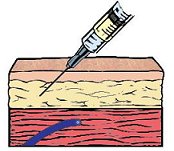
Intravenous
The injection of a drug directly into the patient's veins is the most rapid route of administration, resulting in the most rapid onset of action. Much less frequently used is Intraarterial, injecting drug directly into the patient's arteries.
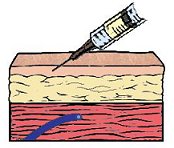
Intradermal
In this route, the drug is injected into the (top few layers) of the skin. Ideally, the drug is placed within the dermis. The intradermal route is used almost exclusively for diagnostic agents.
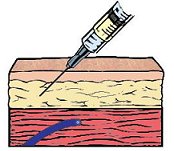
Subcutaneous
This route involves the injection of the drug under the skin into the fatty layer, but not into the muscle. Absorption of the drug is rapid. Insulin is normally administered subcutaneously.
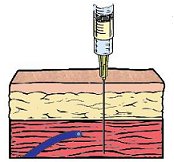
Intramuscular
The intramuscular route is used when drugs are injected deeply into muscle tissue. If the drug is in aqueous (water) solution, absorption is rapid. However, if the drug is in an oily liquid or in the form of a suspension, it can prolong the release of the drug.
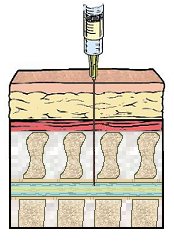
Intrathecal
The intrathecal route involves the administration of a drug directly into the spine (subarachnoid space) as in spinal anesthesia. The intrathecal route is used because the blood-brain barrier often precludes or slows the entrance of drugs into the central nervous system.
Enteral Routes
Oral
Most drugs available today can be administered by mouth
(orally). Drugs can be orally administered in the form of tablets,
capsules, powders, solutions, syrups or suspensions. Drugs administered by the
oral route are usually taken for their systemic effect. These
medications must pass through the stomach and be absorbed in the
intestinal tract. Orally administered medications are usually easy to
take and are usually less expensive than other dosage forms.
Sublingual/Buccal
The
sublingual/buccal route of administration is closely related to the
oral route; however, in the sublingual/buccal route the dosage form is
not swallowed. The tablet is to be dissolved under the tongue
(sublingual) or in the pouch of the cheek (buccal). The drugs
administered in this manner are rapidly absorbed and have the advantage
of bypassing the gastrointestinal tract. Nitroglycerin, for heart
patients, in tablet form is more likely the most frequently administered
sublingual drug.
Rectal / Vaginal
Drugs
administered by the rectal / Vaginal suppository route may have a local effect (such as for
hemorrhoids) or a systemic effect (as in the prevention of nausea and
vomiting). The rectal route is convenient to use in children or in
patients who are unconscious or vomiting. The amount of drug absorbed in
the rectal / vaginal route is usually less than if the drug were administered
orally. The absorption of drugs administered rectally is unpredictable
and can vary among patients.
Inhalation / Inhaler
Inhalation
is a means of introducing medications through the respiratory system in
the form of a gas, vapor, or powder. Inhalation is divided into three
major types: vaporization, gas inhalation, and nebulization.
Vaporization is the process by which a drug is changed from a liquid or
solid to a gas or vapor by the use of heat (such as in steam
inhalation). Gas inhalation is almost entirely restricted to anesthesia.
Nebulization is the process by which a drug is converted into a fine
spray by the use of compressed gas.
Topical (Dermal, Ophthalmic, Otic)
Topical
drugs are applied to a surface area of the body. Topically applied
drugs serve two purposes: Local effect and Systemic effect. For local
effect, the drug is intended to relieve itching, burning, or other skin
conditions without being absorbed into the bloodstream. For systemic
effect, the drug is absorbed through the skin into the bloodstream.
Examples of topical preparations are ointments, creams, lotions,
Transdermal patches, powders, eye drops, ear drops, and shampoos.
Where would you like to go now?